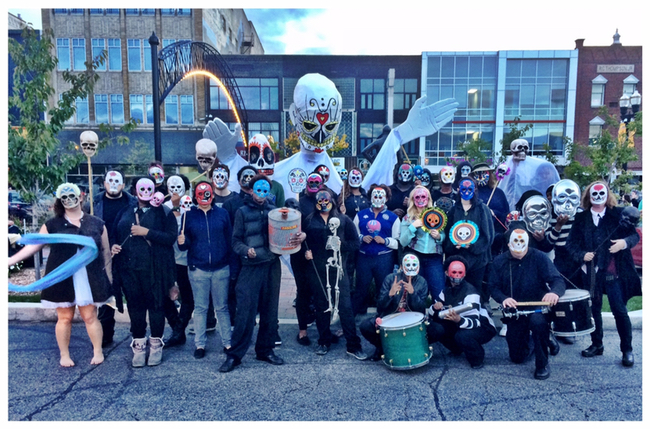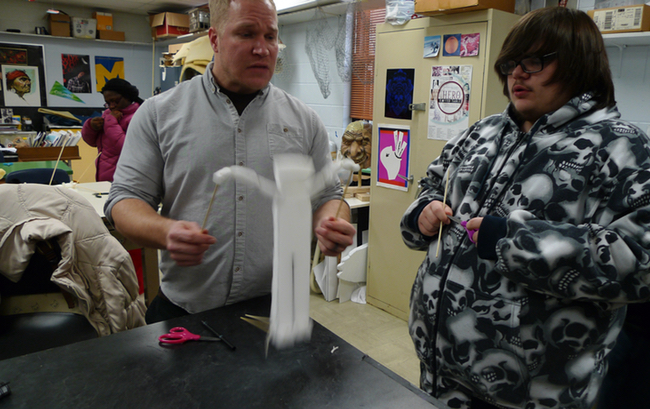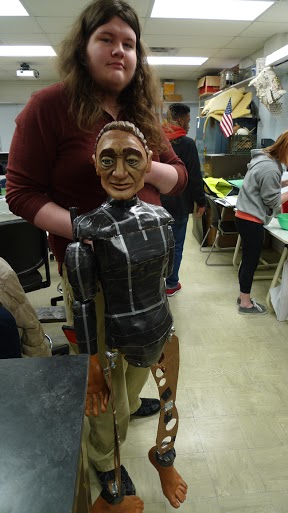Flint ‘middle college’ puts students on a road to work, college

For all its traditions and resonance in American life, its lockers and cafeterias and football teams and hall passes, not every kid is cut out for high school.
For some the problem is discipline, for others, boredom. For others it might be something else entirely. But middle college can be the answer for all of them.
The hub of Mott Middle College High School is on one floor of the Mott Memorial Building at the community college of the same name in Flint.
It is ranked No. 8 among Michigan high schools in the 2014 Academic State Champs rankings, according to an analysis of school data by Bridge and Public Sector Consultants.
With nearly 80 percent of its student body qualifying for free or reduced-price lunch, it nevertheless exceeds expectations on all of its 11th-grade state test scores. It earns an Academic State Champs score of 119.6, with 100 as the “meeting expectations” score.
The oldest middle-college program in Michigan has been sending students on an alternative path to high school graduation and college achievement since 1991.
Students in middle college programs – there are others around the state, all affiliated with a two- or four-year higher-ed institution – go to high school for five years instead of four. But along the way high school becomes a stepping stone to post-secondary education, and everyone graduates with not just a high-school diploma, but at least 15 hours of college credit, all tuition-free.
And most students leave with much more. Former principal Chery Wagonlander said that in recent years, three-quarters of the school’s graduates earn at least 24 hours, and 15 percent had at least 60, enough for some associate’s degrees.
A restrictive label
The Genesee Intermediate School District’s own website describes MMCHS as a place for “at risk” students, but both students and staff dislike the label. While it’s true that most incoming students have below a C average and economic challenges, others choose Mott for its unique approach to learning. Its blended offerings of both high school and post-secondary classes allow non-traditional students – home-schooled, or those with a strong interest in certain areas like fine arts – to pursue studies that give them a head start on higher ed in a supportive environment.
“Students who haven’t found success in a traditional high school setting, given the right tools, will find success here,” said Jerry Johnson, spokesman for the Genesee ISD.
Ironically, one of the ways students find success is by being given a lot more freedom to fail.
The philosophy of the school is grounded in choice and responsibility, said Margaret Green, who took over as principal this year. But it’s coupled with strong individual support that helps students make wise decisions. No one will make a student sit in a cafeteria for the duration of a lunch break, and they are free to go anywhere on the Mott Community College campus. But someone will always have their back.
To that end, twice a week Mott students have a class formally called Focus Group, in which the roughly 400-member student body meet in one of 15 groups that the staff informally call families. Each focus group contains students from first through fifth year, and the group is stable throughout each student’s time at Mott, with younger ones added as they enroll, as older ones graduate. As students rise in seniority, they will be mentors to younger classmates. The Focus class is mostly unstructured, and students use it as a study period, snack time or just a time to unwind.
Students who enroll as freshmen will take their first classes in the Mott Memorial Building. But as they start to sample classes in the college, they will be prepped in side seminars that cover study skills and other support topics. And when they do enter classrooms with students who may be much older, they are not identified to instructors or classmates as high-school students.
“There’s a lot of freedom in this environment,” said Green, the current principal. “It’s a college campus, with flexible schedules. Students skip.” If they skip too much, there’s a sit-down with Green or another staff member, so they fully understand the consequences of repeated absences. But there’s no direct punishment for truancy, as there would be in high school.
“There’s a lot of intervention, long talks, (discussions of) ‘choice theory.’ You get those ‘a-ha’ moments when they understand,” said Robert McAllister, assistant principal. That’s part of the learning experience.
A regional draw
Enrollment is open to all students in the Genesee ISD. Students and parents come to information sessions twice a year and then submit applications. The school evaluates transcripts and behavioral records in making admission decisions, as well as conducting interviews with prospective students. Disqualification for admission is most often due to a poor disciplinary record.
And while enrollment is limited to 400, it most often doesn’t reach full capacity, although it has in the past, McAllister said, and a wait list was instituted.
Depending on the high school the students would attend were they not at Mott, they may have the option of taking extracurriculars there, ranging from sports to music and others, Green said. But that is left up to the home school’s discretion, and not all allow it. It isn’t uncommon to see Mott students wearing jerseys or cheer uniforms from a number of Genesee County high schools on game days.
The school is funded the same as traditional public ones, through the state per-pupil foundation grant. The amount varies according to which local high school’s attendance area each student lives in. A summer prep seminar, research and some outreach are funded with grants from the Mott Family Foundation, but none of those monies go into the general fund, Wagonlander said.
For some students, being treated this way, like an adult, is worth the tradeoffs.
“Sometimes I miss the typical high school things,” said Dezha Peterson, 16, a third-year student. (No one is called a sophomore or junior at MCCHS; it’s first-year, second-year, and so on.) “But when I think of the benefits, it’s not so bad.”
Peterson is interested in a career in human services, and thinks Mott will expose her to a wider range of career options than a more traditional school.
“I don’t know what I want to do yet,” she said. “But I do know I want to explore.”
Mya Walker, another 16-year-old third-year, intends to become a psychiatrist, a career road that requires expensive education stretching well into the future. For her, the decision to attend Mott was very simple.
“Free college,” she said. “I’ll need all I can get.”
See what new members are saying about why they donated to Bridge Michigan:
- “In order for this information to be accurate and unbiased it must be underwritten by its readers, not by special interests.” - Larry S.
- “Not many other media sources report on the topics Bridge does.” - Susan B.
- “Your journalism is outstanding and rare these days.” - Mark S.
If you want to ensure the future of nonpartisan, nonprofit Michigan journalism, please become a member today. You, too, will be asked why you donated and maybe we'll feature your quote next time!
 Students and staff of Mott Middle College High School, calling themselves the Flytown Puppet Theater, paraded at Day of the Dead celebrations in downtown Flint last year, in masks and with puppets they constructed in class. (Courtesy photo)
Students and staff of Mott Middle College High School, calling themselves the Flytown Puppet Theater, paraded at Day of the Dead celebrations in downtown Flint last year, in masks and with puppets they constructed in class. (Courtesy photo) Matthew Osmon, a teacher at Mott Middle College High School, works a puppet made by student Michael Stormer, right. The puppeteering class Osmon helps teach combines art, music, sound, dance and social justice issues. (Photo by Nancy Derringer)
Matthew Osmon, a teacher at Mott Middle College High School, works a puppet made by student Michael Stormer, right. The puppeteering class Osmon helps teach combines art, music, sound, dance and social justice issues. (Photo by Nancy Derringer) Alex Livengood, a student at Mott Middle College High School, shows off “Adam,” a puppet created in a class at the school. (Photo by Nancy Derringer)
Alex Livengood, a student at Mott Middle College High School, shows off “Adam,” a puppet created in a class at the school. (Photo by Nancy Derringer)